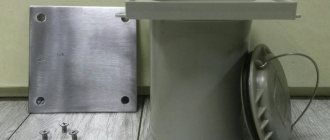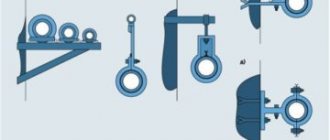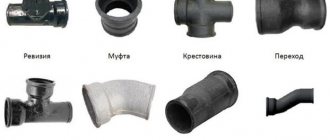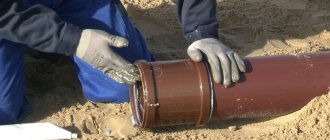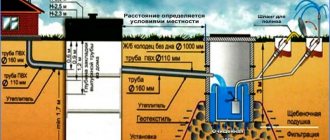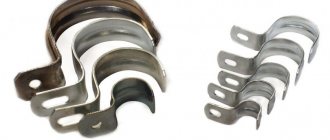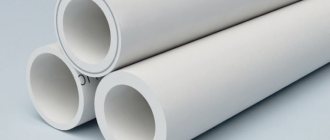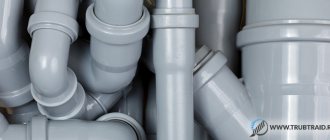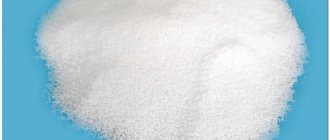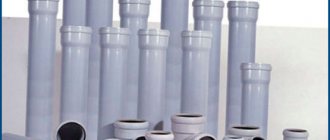For normal operation of the sewer system, so that it can be safely used, the fastening of the pipes must be reliable and of high quality.
When the sewerage system is made using an open method, fixation occurs using clamps that securely fasten the pipeline to the desired surface, according to the developed design documentation. Sewer pipes can be attached to the wall in different ways. You can clamp the pipe very tightly, creating a perfect seal.
Or you can make the clamp fastening somewhat looser. Such a mount will be called floating.
This is specifically done to ensure the integrity of the pipe in case of thermal deformation. Clamps for each type of fastening do not have any differences. They are exactly the same. However, the industry also produces fasteners that are intended only for a floating system. These clamps do not have tightening bolts. This design is very easy to work with, you just need to snap the clamp. Installation of such clamping devices occurs without the use of special equipment.
Basic methods of installing sewer systems
Before laying the entire sewer system in the house, they strengthen the pipes. In order to avoid unpleasant consequences in the future, such installation is carried out skillfully, using various fastening methods:
Types of pipeline fastenings
- to avoid deformation of the pipes during wiring, a compensation method is used;
- fasteners for sewer pipes taking into account sliding friction are used to prevent pipes from deviating from the center line;
- You can strengthen the structure with extra turns using fittings; they are also used to connect pipes with sanitary equipment;
- The optimal and most popular option is fastening with clamps.
The latter method creates a good fixation of sewerage elements. The fastener has a convenient design that allows it to be easily and securely mounted on the wall - it is a dowel, anchor or screw device.
Typically, pipes are included in the pipeline kit, but if the need arises to purchase clamps, you can choose both plastic and metal. But at the same time, you should take into account the design of the room in which the system runs.
Advantages of pipe clamps
Plastic clamps are more suitable for open installation - they are more attractive. With a hidden pipeline, this point is not important, so you can choose metal.
The main types of autonomous sewerage for a country house
Despite the fact that many consider cesspools to be a thing of the past, this type of autonomous sewage system is the easiest to build with your own hands.
An equally important argument in defense of cesspools is the fact that their internal arrangement has now changed.
Before you make a sewer system in your house like a cesspool, you need to find out the engineering and geological features of your site.
The easiest way to build the walls of a cesspool is from brickwork, with red ceramic brick being the most acceptable option.
If it is possible to use additional equipment, then you can build a cesspool from reinforced concrete rings. Experts recommend concreting the bottom of the cesspool, covering the pit with a slab with ventilation and a special inspection hatch.
Are you still undecided on how to make a sewer system in a private house yourself?
We recommend installing a local autonomous sewage system, for example, a septic tank.
This type of sewage system is especially relevant in those houses where people constantly live, and has gained particular popularity among Russians.
The septic tank is quite simple and reliable to use; it can be easily installed on your own by following the step-by-step installation guide (it is included when purchasing a septic tank, for example, their polypropylene).
In addition, septic tanks do not require frequent cleaning, so you will spend less money on calling a sewer truck.
Modern septic tanks are even three-chamber; they have a very high degree of purification of wastewater and domestic water thanks to elements of the aeration system and biofilters.
Sewerage in a private house video will help you decide which type of autonomous sewer system is most suitable for your home and site.
Sequence of actions during the construction of an individual sewer system
Before making a sewer system in the house, you need to decide on the initial steps:
Determine the area where the sewer well (cesspool or septic tank) will be located.
Important: the drainage well must be located below the level of the house. Determine where the sewer exits the house. Carefully inspect the exit point of the collector pipe. Please note that at this point all drains and used water from all plumbing fixtures in your home will accumulate (kitchen sink, toilet, bathtub, boiler). Inspection of the place where water enters from the entire house is necessary in order to to ensure that the collector is installed correctly (there should be no distortions or deviations). Only after a preliminary inspection has been carried out can a preliminary design for the sewer system of a private house be drawn up. Please note: the external sewer system is usually straight, the internal sewer system usually has many bends and angles. Therefore, when drawing up its project, it is very important to calculate all the dimensions of the pipes, their bends, and so on. Only after everything has been thought out and calculated can you begin to purchase the necessary materials. We begin the installation of external and internal sewerage systems.
Installation of a sewer system using a clamp
Fastening sewer pipes using clamps allows you to avoid the occurrence of stress and linear deformations in the system. This problem is solved by two types of fasteners:
- pipeline displacement can be prevented by using rigid fixation. In this case, the fasteners are located below the level of the socket and are used in situations where full tightening of the pipe is necessary;
- sometimes they resort to the floating installation method. In this situation, the pipe has the ability to move longitudinally over a short distance.
Scheme of fastening pipes with a clamp
Structurally, the clamp is a set of the following elements:
Clamp diagram for fastening pipes
- U-shaped or round screed;
- retainer;
- fastening unit mounted on a self-tapping screw;
- anchor or dowel.
Quite simple parts ensure reliable fastening of pipes to the walls.
There are two types of plastic screed - detachable and permanent. Metal (steel) - only detachable, and supplemented with a rubber gasket, which perfectly dampens vibrations.
In the U-shaped version there is no lock, and in the rounded steel pipe it is a bolted connection. For polymer screeds, special latches with reliable fixation are used.
At the bottom of the clamp (both detachable and non-detachable) a fastening unit is fitted. The outlet is mounted on the wall in 3 ways - screw (with anchors), driven in (dowels), according to a T-shaped pattern (straight rod).
Types of fasteners
To reliably fix the sewer pipeline, it is necessary to select the correct pipes. Before you go to the store, you should study what types of sewer pipe fastenings are available:
Sewer pipe fastening - diagram
- crimp fasteners are used to fix the joint at the junction of the fitting and the outlet, this ensures a hermetically sealed connection between the structural elements;
- in places where the pipeline is installed on supporting surfaces, guide elements are used to position the elements;
- Sewer pipes are fastened directly to the wall using support fasteners. An additional installation element is rubber compensators that protect against vibrations;
- in difficult sections of pipeline laying, additional fastening is required to provide support for the structures. Safety pipes are used for this purpose.
If we consider the types of fasteners from the point of view of the type of fixation, then for the rigid version it is necessary to take support or crimping devices. Safety and guides are more suitable for floating mounts.
What's better?
Clamps seem to be more universal means of fastening. They can implement both rigid and floating fastening technologies. To do this, it is enough to adjust the tightening force of the screw connections.
They can handle any pipe diameter and are suitable for installing sewer lines made of both metal and polymer. The use of products with dowel nails increases the speed of pipeline installation by an order of magnitude, without in any way reducing the quality of fastening.
Ceiling and wall fixing options
Installation of pipes to the wall
Sewerage is a rather complex structure that includes many elements and devices. If the sewer pipe is incorrectly secured in at least one area, this will lead to changes in internal pressure, blockages, vibrations, and deformations. As a result, the entire system will fail.
Rules to follow during installation:
Scheme for attaching sewer pipes to the wall and ceiling
- Pipeline marking is carried out taking into account branches, bends and connections of structural elements.
- When laying the line of the future sewerage system, take into account the degree of slope (the minimum is 20 mm/l.m.).
- A large number of turns should be avoided - their frequency will affect the operation of the entire system.
- Fastening for sewer pipes is carried out.
- When laying pipes in a U-shaped screed, the pipe should be slightly shifted along the center of the axis before fixing. After this, you need to tighten the lock.
- It is important to maintain the distance between the fasteners; it depends on the material of the clamp. Steel ones are located at a distance of 1.5 m from each other, polymer ones - at least 2 m.
- After the entire system is assembled, it is necessary to check the reliability of all clamps in order to avoid troubles during operation.
Rules
When designing and installation work, it is necessary to use the rules and requirements set out in the following documents:
- SNiP 2.04.01–85: Sanitary Norms and Rules “Internal water supply and sewerage of buildings”;
- SNiP 2.04.03–85: Sanitary Norms and Rules “Sewerage. External networks and structures."
For internal sewerage:
- The productivity of the spillway system, on average, should be calculated based on consumption rates per person of 100–200 liters per day.
- The toilet is installed separately. The entrance to the main riser is a self-connection. There should be no other plumbing fixtures between it. When there is a massive release of water, a local hydraulic shock occurs. The result is the suction of liquid from the siphons, which acts as a water seal. It follows that the toilet must close the chain in the general drainage system.
- The diameter of the outlet pipes is the same size or increases as it approaches the main riser.
- The distance of the toilet from the riser should not exceed 1 meter. Other sources of waste – no more than 3 meters.
Approximate data for the installation of plumbing fixtures and slope:
| Plumbing device | Standard slope indicator | Distance from the main riser (drain) and the device, no more, cm | Diameter of drain pipes, not less, mm |
| Bath | 1 : 30 | 100–130 | 40 |
| Toilet | 1 : 48 | 150–170 | 40 |
| Shower cabin | 1 : 20 | up to 100 | 40 |
| Wash basin | 1 : 12 | up to 80 | 40 |
| Bidet | 1 : 20 | 70–100 | 30–40 |
| Kitchen sink | 1 : 36 | 130–150 | 30–40 |
| Combined drain (bathtub, sink, shower) | 1 : 48 | 170–230 | 50 |
| Central riser | 100 | ||
| Branches from the riser | 50–70 |
Ventilation must be provided. This could be the main riser facing the roof. Or a separate fan pipe.
Note. You cannot combine a general ventilation system and a vent riser. In this case, unpleasant odors will be able to enter the living quarters.
Some installation features and expert advice
Fastening of sewer pipes is carried out taking into account the following features:
Fastening the sewer riser with clamps
- fittings and guide clamps are installed in areas of slopes;
- in areas where the system branches or makes bends, turns, as well as at joints, branches are required;
- floating, fixed and rigid clamps should be alternated with each other - this will ensure uniform load distribution.
Experienced craftsmen resort to a little trick when laying a pipeline - they install sewerage into shallow grooves on the wall. This allows you to increase the strength and reliability of the entire system and save on the number of installed elements. In addition, laying pipes in the wall channel will play an important role in the design of the room.
Related video: Pipe fasteners - how to choose
Publications on the topic
Options for fastening drainage systems
How to repair a hole in a concrete wall or ceiling
Selection and application of sealant for sewer pipes
Related Posts via Categories
- Shaped parts of sewer pipes are important building blocks of the network
- Diameters of sewer pipes - what are they produced and how are they used?
- The slope of the sewer pipe must be strictly observed!
- Angle of inclination of sewer pipe for internal and external systems
- Service life of cast iron sewer pipes and methods for extending it
- Flushing sewer pipes - removing simple and complex blockages
- Sewer pipes – which is better, steel or PVC?
- Repairing sewer pipes in an apartment with your own hands is not a problem!
- Corrugated sewer pipe – perfect sewerage!
- Sewer pipes and fittings – which ones to choose?
